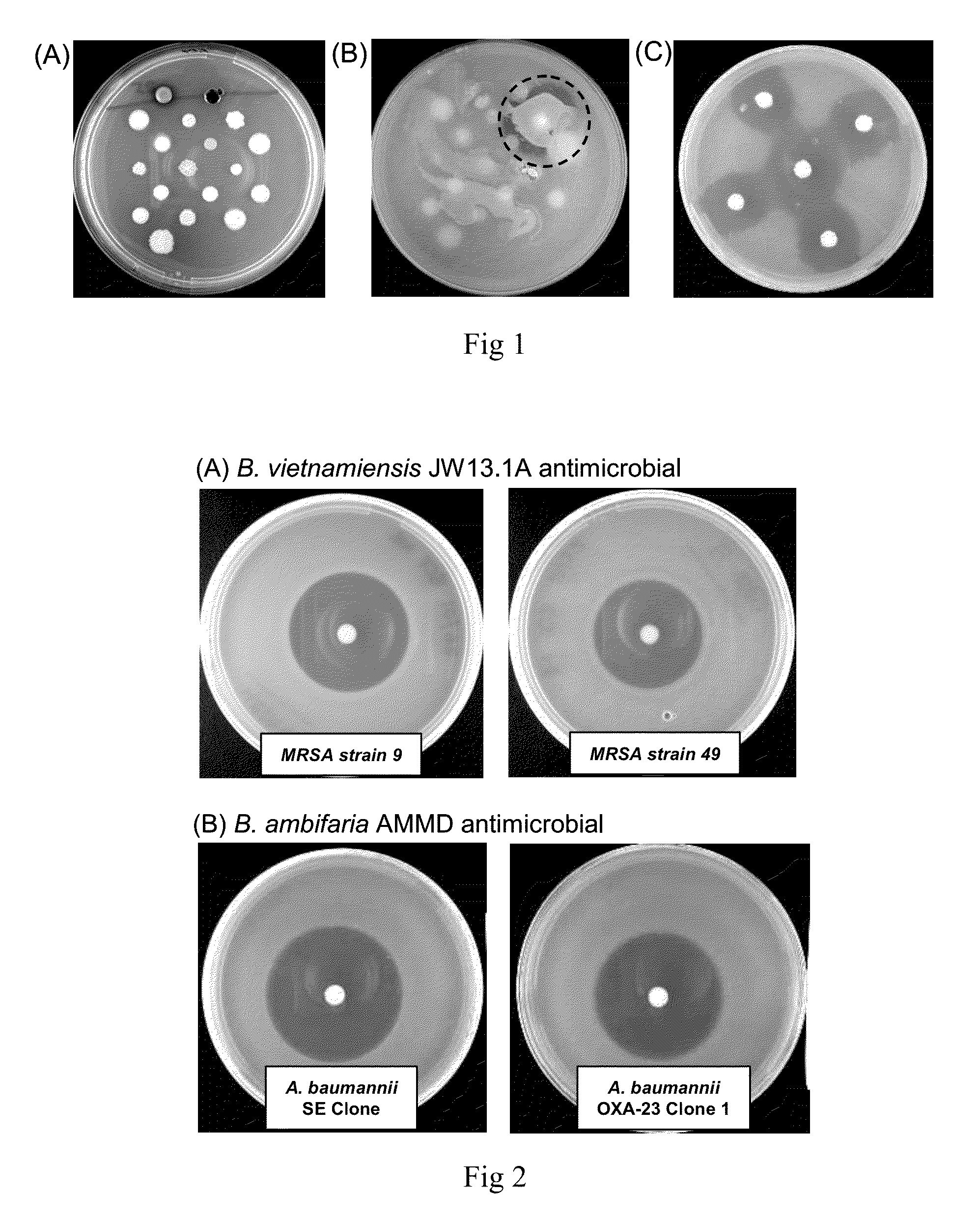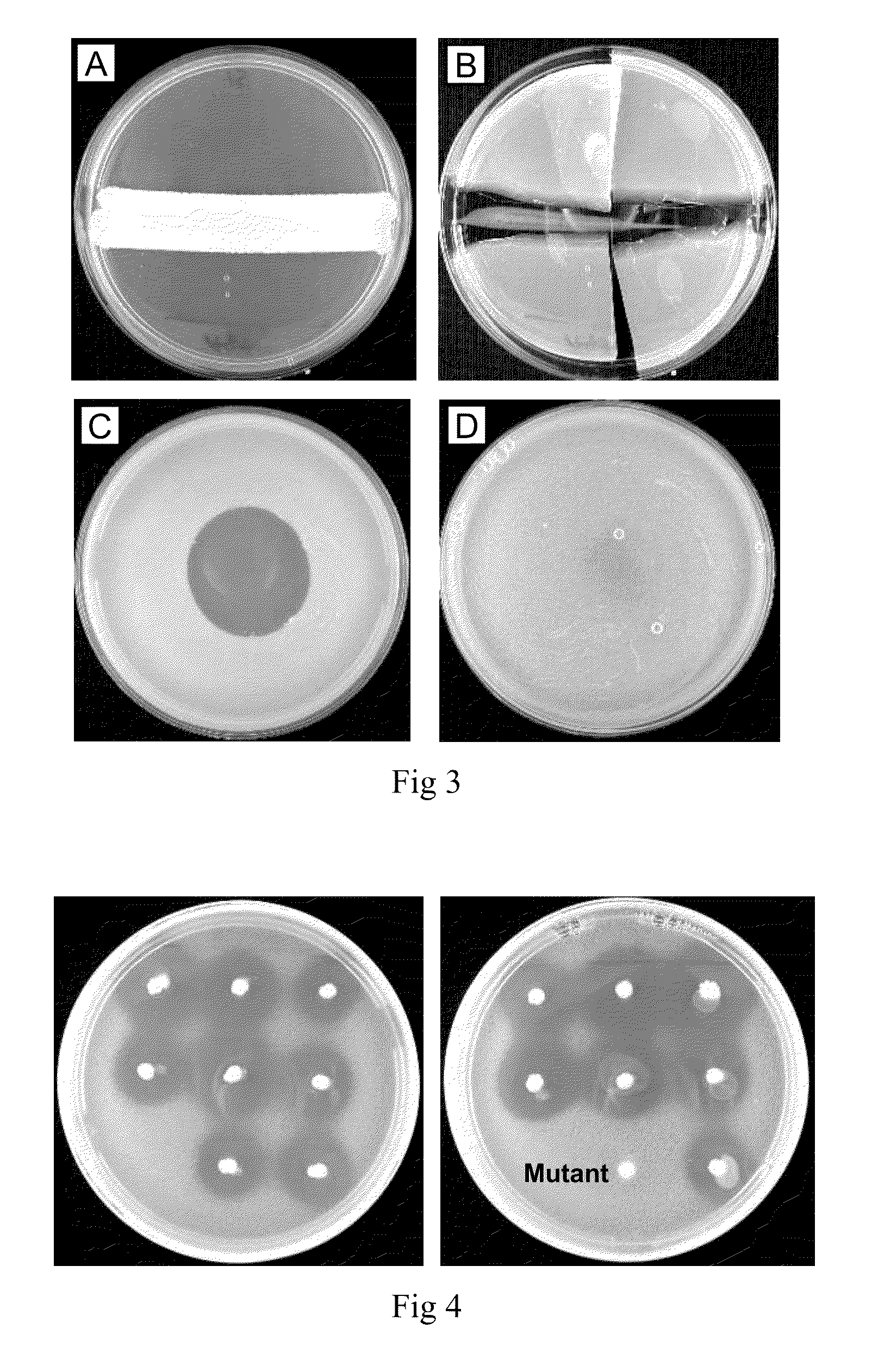Antimicrobial agent and method for the production thereof
a technology of antimicrobial agents and antimicrobial agents, which is applied in the direction of antibacterial agents, bacteria material medical ingredients, and processes based on bacteria, can solve the problems of cf patients being susceptible to chronic respiratory infections, bacterial infections that remain difficult to treat, and bacterial infections that are increasingly difficult to treat, and achieves a potent anti-gram negative
- Summary
- Abstract
- Description
- Claims
- Application Information
AI Technical Summary
Benefits of technology
Problems solved by technology
Method used
Image
Examples
example 1
[0140]The Cardiff Bcc collection was screened for the production of antimicrobials capable of inhibiting the growth of four bacterial species:[0141](i) B. cenocepacia as a representative dominant Bcc CF species (11);[0142](ii) B. multivorans as the most dominant Bcc CF species now seen in the UK CF population (5);[0143](iii) Pseudomonas aeruginosa as the major CF pathogen (5); and[0144](iv) Staphylococcus aureus, as a representative gram positive CF infection (5).
[0145]A trial experiment was performed, where 18 Bcc isolates representative of the current species as well as genome reference strains were examined for antimicrobial production. This involved inoculating Bcc isolates onto minimal media containing different carbon sources, leaving them to grow at 30° C. until stationary phase, and then overlaying them with soft-agar containing one of the four test susceptibility species listed above. The very first experiment (FIG. 1, panel A and B) demonstrated that B. ambifaria strain AM...
example 2
[0146]A collection of 267 genetically distinct Bcc strains (Table 3) was screened using the methods described above. The ability to inhibit B. multivorans, P. aeruginosa and S. aureus was examined; no inhibition of B. cenocepacia had been seen in other trial experiments, therefore susceptibility of this organism was not explored further. The results of this screen were staggering, with over 40% (109 strains) of the Bcc bacteria screened demonstrating antibacterial activity in the form of a zone of clearing of the test susceptibility species (Tables 1, 2 and 3; FIG. 1). All Bcc strains described herein with antimicrobial activity can be specifically identified using MLST (1) and their specific ST is reported in Tables 1 and 2.
[0147]Two strains with significant novel antimicrobial activity described here are well studied B. cepacia complex isolates that already been submitted to an IDA as part of ongoing research on these bacteria (B. ambifaria AMMD [LMG 19182T] and B. vietnamiensis P...
example 3
[0157]The spectrum of inhibition produced by B. ambifaria strain AMMD was subsequently found to be as follows:[0158](i) Inhibition of B. cepacia complex species. Ambifarin A inhibited all B. multivorans (24 strains), B. dolosa (8 strains), B. anthina (14 strains) and B. pyrrocinia (16 strains) tested (strains were drawn from those screened in Table 1).[0159](ii) Inhibition of gram negative pathogens. The antimicrobial inhibited: Pseudomonas species (P. putida, P. fluorescens and P. stutzeri; only B. ambifaria strain BCC0203 (LMG-P24640; Table 2) produced some inhibition of P. aeruginosa); Ralstonia species (R. mannitolytica and R. pickettii), multiresistant strains of Acinetobacter baumannii (FIG. 2, panel B) and several isolates of Stenotrophomonas maltophilia.
[0160]Ambifarin's broad spectrum and activity on multidrug resistant gram negative pathogens (Stenotrophomonas and Acinetobacter species) is very promising and of global importance in terms of combating infection with resist...
PUM
| Property | Measurement | Unit |
|---|---|---|
| temperature | aaaaa | aaaaa |
| temperature | aaaaa | aaaaa |
| temperature | aaaaa | aaaaa |
Abstract
Description
Claims
Application Information
 Login to View More
Login to View More - R&D
- Intellectual Property
- Life Sciences
- Materials
- Tech Scout
- Unparalleled Data Quality
- Higher Quality Content
- 60% Fewer Hallucinations
Browse by: Latest US Patents, China's latest patents, Technical Efficacy Thesaurus, Application Domain, Technology Topic, Popular Technical Reports.
© 2025 PatSnap. All rights reserved.Legal|Privacy policy|Modern Slavery Act Transparency Statement|Sitemap|About US| Contact US: help@patsnap.com



